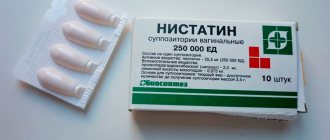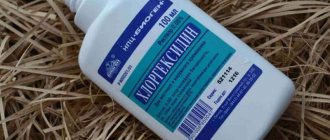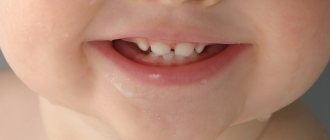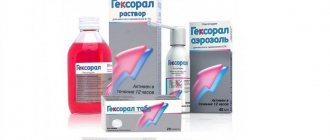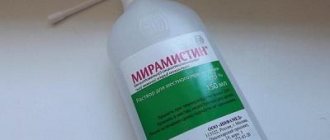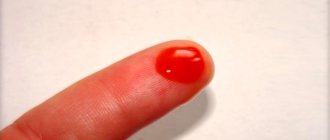Treatment of thrush in infants with sodium tetraborate
Candidal stomatitis (thrush) is a common disease among newborns, caused by the activation of the yeast-like fungus Candida.
It appears as a white cheesy coating on the mucous membrane of the mouth. Its main causes are infection from the mother at the time of childbirth or during feeding, weakened immunity, and failure to comply with hygiene rules. Because of thrush, babies cannot eat normally and are constantly restless.
Various antifungal agents are used to treat it. One of them is sodium tetraborate.
General characteristics
Sodium tetraborate is a salt formed by the interaction of sodium and boric acid, popularly called borax. This substance is widely used in the food industry as a preservative with the designation E285. Dry borax concentrate is an insecticide - it effectively fights cockroaches.
For medical purposes, sodium tetraborate is used in dentistry and gynecology as an external antifungal and antiseptic agent. It is produced in the form of a clear, colorless solution containing 20% active substance and 80% glycerol. The medicine is packaged in dark bottles with a capacity of 30 g.
The drug is sold without a prescription. Cost – 9 – 30 rubles. depending on the manufacturer. It is recommended to store it at a temperature of 15-25°C.
The instructions contain the following list of indications for the use of sodium tetraborate:
- stomatitis
- vaginal candidiasis, colpitis
- bedsores, skin cracks, diaper rash
- fungal tonsillitis, pharyngitis
How does the remedy work? Borax affects the vital activity of fungi that cause inflammation of the mucous membranes and skin: it removes Candida mycelium and prevents them from attaching to the surface of epithelial cells, as a result of which the process of their reproduction is disrupted. Glycerol, which is part of the drug, enhances the effect of sodium tetraborate and reduces tissue irritation.
The use of the solution in newborns and children of the first year of life is controversial in the medical community. In many foreign countries it is banned in pediatrics due to its high toxicity.
In the post-Soviet space, many doctors recommend it as an effective remedy for oral thrush. In practice, when borax is applied topically in glycerin in safe dosages, problems arise extremely rarely.
But in infants it can only be used under the supervision of a doctor.
How to lose weight after childbirth?
Many women after childbirth face the problem of excess weight. For some, it appears during pregnancy, for others, after childbirth.
- And now you can no longer afford to wear open swimsuits and short shorts...
- You begin to forget those moments when men complimented your flawless figure...
- Every time you approach the mirror, it seems to you that the old days will never return...
But there is an effective remedy for excess weight! Follow the link and find out how Anna lost 24 kg in 2 months.
Rules of application
Instructions for the use of sodium tetraborate for thrush in infants:
- It is necessary to wash your hands thoroughly with soap and dry them.
- A sterile bandage or gauze should be wrapped around the index finger of the right hand.
- You need to drop some medicine onto the material and wipe the child’s entire surface of the oral mucosa: palate, tongue (from root to tip), cheeks, gums. In this case, it is necessary to carefully clean off the plaque without damaging the tissue.
- Before going to bed at night, it is recommended to wipe the pacifier with medicine.
The procedure must be repeated 2-3 times a day after feeding. Duration – 5-7 days. It is advisable to treat the mouth with the solution for several more days after the signs of stomatitis have completely disappeared.
It is better not to use cotton swabs, disks or balls for wiping: due to their soft texture, plaque cannot be effectively removed.
Security measures
Sodium tetraborate is contraindicated in:
- individual intolerance to the substance
- renal failure
- serious skin damage
- pregnancy
Possible side effects:
- burning and redness at the application site
- allergies in the form of swelling, itching, rash
When using increased doses of the drug the following are observed:
- vomiting, diarrhea
- stomach ache
- weakness
- headache
- convulsions
In case of such problems, the baby must be taken to a medical facility, where gastric lavage, diuresis and restoration of water and electrolyte balance will be carried out.
To avoid negative reactions, sodium tetraborate in newborns should be used only externally in minimal quantities and for no longer than 7 days. If during this period the symptoms of thrush have not decreased, it is recommended to consult a doctor to adjust the treatment regimen.
Do not combine borax with medications containing clotrimazole and other antimycotic substances, as well as boric acid, phenol and corticosteroids.
To treat mild forms of candidal stomatitis, you can use another remedy with sodium - sodium carbonate or baking soda. Preparing a medicinal solution is very simple: dissolve a teaspoon of the substance in a glass of boiling water.
It is necessary to dip a sterile bandage wrapped around the index finger into the cooled product and wipe the inside surface of the child’s mouth with it. It is recommended to carry out the procedure 30 minutes before feeding every 2-3 hours. Treatment period is 5-7 days.
Sodium bicarbonate is less effective than tetraborate, but does not have such high toxicity. It can be used in newborns without fear.
In parallel with treating the baby’s mouth, it is necessary to wipe the nursing mother’s nipples or pacifiers and bottles with a soda solution before each feeding (after preliminary boiling). It is also worth washing all soft toys and pouring boiling water over hard ones.
Prevention measures
To prevent thrush in babies you need to:
- wash your hands before every contact with your child
- periodically clean and wash toys
- keep your breasts clean - rinse them with water before each feeding, wash them twice a day with baby soap, change breast pads regularly
- Sterilize bottles, pacifiers and pacifiers
- use separate dishes for baby food
- give the baby a few sips of boiled water after each feeding to remove any remaining milk or formula from the mouth
- control the air parameters in the children's room - humidity should be 60-70%, and temperature 18-22 ° C; in drier and warmer air, the baby's oral mucosa will dry out, and lack of saliva is one of the factors in the activation of fungi
- clean the baby’s nose of mucus and crusts using saline solutions so that he does not breathe through his mouth
- carry out restorative hardening
Sodium tetraborate is an effective and very affordable treatment for thrush in infants.
But due to its high toxicity, it must be used very carefully: do not exceed the dosage and do not prolong the treatment period. The drug should be used only as prescribed by a pediatric dentist or pediatrician.
Do not forget about preventative measures for candidal stomatitis in order to prevent re-infection of the baby.
Every third mother experiences thrush in her baby.
As a rule, candidiasis is localized on the mucous membranes of the oral cavity, which causes great anxiety and pain to the baby.
Pediatricians in Russia recommend that young mothers use sodium tetraborate for thrush in infants. We will understand how to use the drug correctly so as not to harm the baby in our material.
Sodium tetraborate is a derivative of boric acid. Simply put, it is borax (a salt that is formed as a result of the interaction of boric acid and sodium) enclosed in glycerin. The drug is sold in the form of a solution, bottled in tinted glass bottles with a capacity of 30 ml. The composition of the drug is 20% borax and 80% glycerin.
The main properties of sodium tetraborate are antiseptic and bacteriostatic. The use of the drug helps to destroy the Candida fungus.
In addition, the product prevents the attachment of the fungus to the child’s oral mucosa and at the same time destroys the cell membrane of the pathogenic flora.
At the same time, glycerin, which is part of the drug, is aimed at enhancing the effect of borax and at the same time softening the mucous membranes.
Important: the use of sodium tetraborate should be prescribed exclusively by the treating pediatrician. Self-administration of any medications to an infant is strictly prohibited.
The instructions for use of the drug state that it can be prescribed in the following cases:
- Oral candidiasis in infants (thrush/stomatitis);
- Vaginal candidiasis and colpitis;
- Fungal infections of the throat and sore throat;
- Diaper rash on the skin, bedsores, cracks in the skin.
Contraindications
It is worth knowing that sodium tetraborate is strictly contraindicated in the following cases:
- Kidney failure;
- Individual intolerance to the components of the drug;
- Pregnancy;
- Open wounds on the skin.
It is worth understanding that when using borax in the treatment of thrush in newborns, the following adverse reactions may occur:
- Moderate redness in areas where the mucous membrane was treated with the drug;
- Burning and itching;
- Swelling in the form of an allergic reaction;
- Rash.
In case of an overdose of the drug, the baby may experience the following reactions:
- Abdominal pain;
- Vomiting, diarrhea;
- Weakness and cramps;
- Headache.
If the mother observes similar symptoms of overdose in the baby, it is necessary to take the newborn to the hospital as soon as possible for detoxification procedures. In this case, the baby will undergo gastric and intestinal lavage, as well as IV drips to restore water and electrolyte balance.
To prevent the risk of overdose, it is recommended to use the drug in newborns for no more than seven days and only in minimal doses. If, during treatment with sodium tetraborate, the baby’s thrush does not go away within a week, it is advisable to contact the pediatrician again to make an accurate diagnosis and prescribe a new treatment.
Possible adverse reactions
It is worth understanding that when using borax in the treatment of thrush in newborns, the following adverse reactions may occur:
- Moderate redness in areas where the mucous membrane was treated with the drug;
- Burning and itching;
- Swelling in the form of an allergic reaction;
- Rash.
In case of an overdose of the drug, the baby may experience the following reactions:
- Abdominal pain;
- Vomiting, diarrhea;
- Weakness and cramps;
- Headache.
If the mother observes similar symptoms of overdose in the baby, it is necessary to take the newborn to the hospital as soon as possible for detoxification procedures. In this case, the baby will undergo gastric and intestinal lavage, as well as IV drips to restore water and electrolyte balance.
To prevent the risk of overdose, it is recommended to use the drug in newborns for no more than seven days and only in minimal doses. If, during treatment with sodium tetraborate, the baby’s thrush does not go away within a week, it is advisable to contact the pediatrician again to make an accurate diagnosis and prescribe a new treatment.
Important: it is strictly forbidden to use borax in combination with drugs based on clotrimazole and other antifungal components. It is also prohibited to use boric acid with corticosteroids and phenol.
What kind of drug is this?
Sodium tetraborate is a drug that has antiseptic and bacteriostatic properties. Most often it is used in such areas of medicine as dentistry and gynecology.
The substance is used only externally for rinsing the mouth, douching, and also treats bedsores, diaper rash, etc. It acts through direct interaction with a fungal infection, that is, when applied to the affected mucosa.
The drug is used for lesions:
- Mucous membranes;
- Respiratory tract;
- Urinary tract;
- Nasal cavity.
Contraindications:
- Intolerance to the components included in the drug.
- The presence of wounds and scratches on the treated surface of the skin.
Carefully:
- Pregnancy and lactation period.
- Childhood.
The use of a drill can also cause side effects, including: the appearance of redness or burning in the area of the skin where the medicine was applied, as well as the appearance of seizures in children.
With prolonged use of the drug, there is a possibility of chronic intoxication of the body. If you notice the following symptoms, stop using the product immediately and consult a doctor:
- The appearance of seizures.
- Prerequisites for the development of anorexia.
- Frequent pain in the abdominal area, as well as stool disturbances.
- In women, this is a menstrual cycle disorder.
Prevention measures
To prevent thrush in babies you need to:
- wash your hands before every contact with your child
- periodically clean and wash toys
- keep your breasts clean - rinse them with water before each feeding, wash them twice a day with baby soap, change breast pads regularly
- Sterilize bottles, pacifiers and pacifiers
- use separate dishes for baby food
- give the baby a few sips of boiled water after each feeding to remove any remaining milk or formula from the mouth
- control the air parameters in the children's room - humidity should be 60-70%, and temperature 18-22 ° C; in drier and warmer air, the baby's oral mucosa will dry out, and lack of saliva is one of the factors in the activation of fungi
- clean the baby’s nose of mucus and crusts using saline solutions so that he does not breathe through his mouth
- carry out restorative hardening
Sodium tetraborate is an effective and very affordable treatment for thrush in infants. But due to its high toxicity, it must be used very carefully: do not exceed the dosage and do not prolong the treatment period. The drug should be used only as prescribed by a pediatric dentist or pediatrician. Do not forget about preventative measures for candidal stomatitis in order to prevent re-infection of the baby.
In the video, Dr. Komarovsky talks about fungal infections in children. Take a look because this information may be useful.
Thrush in children
Most often, adolescent girls and children in the first year of life are susceptible to candidiasis. In most cases, they were infected with Candida fungus from their mother. It is quite simple to determine the signs of illness in a child. The most important symptom is the appearance of a white, cheesy coating on the tongue; later, bright pink erosions begin to appear underneath it. Over time, they turn into sores, which become painful. The baby becomes more capricious and even refuses food.
- First, wash your hands thoroughly and dry them. Then we take the container with the medicine and drain the solution a little to clean the neck.
- Next, take a sterile gauze cloth and wrap it tightly around your finger. Pour a few drops onto a napkin and treat the area affected by the fungus, trying to remove the plaque that has formed.
Be prepared that your child will not like such actions on the mucous membrane of his mouth. But they are necessary to achieve visible results in treating the disease. They should be carried out 2 times a day, after several procedures improvements should be noticeable. If these are not observed, it is better to consult a pediatrician.
Thrush in children is a fungal infection of the oral mucosa and skin caused by a rapid increase in the amount of Candida fungus. As a rule, children under the age of one year are susceptible to this disease.
To treat and prevent the appearance of candidal stomatitis, various medications are used to help destroy fungi in the child’s body and the environment, and suppress the excessive growth of fungal flora.
The most common cause of the disease is infection of the baby from the mother, which occurs during the passage of the fetus through the birth canal or during breastfeeding. Other people can also infect the baby, for example, during play or kissing. Also, the causes of candidal stomatitis may be:
- High temperature and excessively dry indoor air. Such conditions are ideal for the growth of fungal infections, which are quite difficult for children’s immunity to cope with.
- Disturbance of microflora - most often this disruption in the body occurs due to the use of antibiotics. Tendency of the oral mucosa to dryness. As a rule, this happens due to infrequent wet cleaning and dry air in the room where the child spends a lot of time.
- Failure to comply with hygiene rules - any infection significantly weakens the baby’s immune defense, so the fungal infection spreads quickly.
In most cases, the disease begins with small reddened areas appearing on the tongue, cheeks, gums, and lips, and after a couple of days they become covered with a white coating.
After some time, the lesions increase in area, and the plaque itself may change color to yellowish or gray.
The affected areas of the mucous membrane can be small or occupy almost the entire oral cavity.
After clearing the baby's mouth of secretions, bright red spots remain on the mucous membranes, from which blood may be released.
The more extensive the area affected by thrush, the more discomfort the child experiences. Symptoms that characterize candidal stomatitis include:
- the appearance of plaque in the mouth;
- increased salivation;
- decreased appetite;
- restless behavior;
- in advanced cases, the above symptoms are supplemented by fever and digestive disorders.
More interesting: Thrush in children in the groin area
Sodium tetraborate for thrush in a newborn is used to completely cure the disease. This drug has a detrimental effect on fungal mycelia concentrated on the mucous membranes.
The medicine has an inhibitory effect on the fungus, resulting in recovery. When using the product, you must strictly adhere to the prescribed dosage and frequency, since the medicine is toxic.
Sodium tetraborate is a salt formed as a result of the interaction of boric acid and sodium, which is also called “borax”. It applies:
- for the destruction of insects living in residential premises, since it is an insecticide;
- in the food industry - the substance is a preservative E285; for treatment - for gynecological and dental diseases.
The medicine is produced in the form of a colorless solution, consisting of 80% glycerol and 20% of the main active ingredient, packaged in opaque bottles of 30 grams. In pharmacies, the drug is sold to customers without presenting a prescription written by a doctor.
Sodium tetraborate is especially effective for thrush in infants, as well as for a number of other diseases - for:
- colpitis;
- the formation of diaper rash, dermatitis or bedsores on the skin;
- pharyngitis;
- stomatitis;
- fungal tonsillitis.
The effectiveness of the product is due to its complex action - borax removes fungal mycelia and does not allow them to gain a foothold on the mucous membrane, which interrupts the process of increasing their number, and glycerol enhances the effect of the first substance and reduces the irritation that occurs on the mucous membranes.
The use of sodium tetraborate for thrush in infants is allowed only after receiving medical advice, since the drug is toxic.
Borax is a fairly effective substance that allows you to cope with thrush in babies, but it should be used strictly as prescribed and without violating the terms of use.
To combat candidal stomatitis, it is often recommended to use sodium tetraborate; the instructions for use of this drug for thrush are simple:
- Hygiene procedures are carried out - hands are thoroughly washed with soap or another cleanser and dried.
- A sterile bandage is wrapped in several layers on one finger.
- The baby's mouth opens gently.
- A small amount of solution is applied to gauze.
- The entire oral cavity is wiped with a bandage - tongue, cheeks, gums, palate. Plaque must be removed carefully, with slight pressure, so as not to injure the mucous membrane.
More interesting: Candidiasis in children
The procedure should be carried out 3-5 times a day, after the child has eaten. The course of therapy lasts up to 7 days. If the thrush has passed before this period, you should treat the child’s mouth for a couple more days to prevent a recurrence of the disease. In addition, it is recommended to treat the pacifier with this solution - this will speed up the healing process.
Side effects
Reviews about the use of sodium tetraborate for thrush in infants are mostly positive. But we cannot fail to mention the side effects of borax, which, if they occur, require stopping therapy and contacting a medical professional. These include:
- severe burning and redness after using the drug;
- the occurrence of digestive problems;
- dysfunction of the nervous system - fatigue, convulsions, lethargy (these symptoms appear during poisoning);
- skin reactions - the occurrence of alopecia or dermatitis.
To avoid side effects, it should be noted that sodium tetraborate should not be used simultaneously with the use of antifungal agents containing clotrimazole, as well as with drugs that contain phenol, boric acid, or corticosteroids.
Contraindications
This product has a number of contraindications, the absence of which must be ensured before using it. In particular, the products should not be used by pregnant women, those with kidney disease or liver disease, if individual intolerance to the components has been identified, or in the presence of serious skin damage.
If symptoms of drug poisoning appear, it is necessary to contact a medical institution, where the child will undergo gastric lavage and restore the water and electrolyte balance.
To avoid negative consequences, the drug is used exclusively externally, using a minimal amount of solution. The course of procedures should not exceed 7 days.
Sodium tetraborate (borax) is an affordable and quite effective remedy that should be used to treat infants for thrush with caution due to the toxicity of the active substance.
The product should be used only after recommendations received from a pediatrician or dentist.
And to prevent candidal stomatitis from occurring again, we must not forget about preventive measures - maintaining hygiene, maintaining optimal temperature and humidity in the nursery, strengthening children's immunity.
Loading…
Rules of application
Instructions for the use of sodium tetraborate for thrush in infants:
- It is necessary to wash your hands thoroughly with soap and dry them.
- A sterile bandage or gauze should be wrapped around the index finger of the right hand.
- You need to drop some medicine onto the material and wipe the child’s entire surface of the oral mucosa: palate, tongue (from root to tip), cheeks, gums. In this case, it is necessary to carefully clean off the plaque without damaging the tissue.
- Before going to bed at night, it is recommended to wipe the pacifier with medicine.
The procedure must be repeated 2-3 times a day after feeding. Duration – 5-7 days. It is advisable to treat the mouth with the solution for several more days after the signs of stomatitis have completely disappeared.
It is better not to use cotton swabs, disks or balls for wiping: due to their soft texture, plaque cannot be effectively removed.
Instructions for the use of sodium tetraborate for thrush
Remember, it is dangerous for pregnant women to use sodium tetraborate for thrush. Therefore, before starting therapy, you should consult your doctor. Typically, this medication is not prescribed during pregnancy and lactation (or is prescribed with great caution) due to the toxicity of the substance. In just a few uses, it can accumulate in the body, which will negatively affect the health of the mother and penetrate through the placenta to the fetus.
Thus, borax is an inexpensive but effective remedy for treating mucous membranes from Candida fungus in both women and infants. It does not require any supernatural actions during the procedure, and improvements are noticeable after just a few uses. But it must be remembered that borax is not the basis for treating a fungal infection, but only complements a set of measures to combat the disease.
We must not forget about the possibility of side effects during use of the medicine, and about contraindications. Do not self-medicate; before starting to use 20% sodium tetraborate in glycerin, consult a specialist.
Candidiasis is a common disease that occurs in almost every woman at least once in her life. Treating this disease can sometimes be a major challenge. The disease is certainly curable, but recovery can often take a long time.
The cause of the disease is a fungal infection. Normally, fungi are natural inhabitants of our body, but under certain conditions their uncontrolled growth and reproduction occurs, as a result of which the clinical symptoms of thrush appear.
The leading role in the occurrence of the disease is played by the state of the immune system, which controls the growth of fungal infection. When the immune system is weakened, yeast-like fungi get out of control, forming entire colonies.
Sodium tetraborate for thrush is an effective remedy that will help you get rid of the unpleasant symptoms of a painful illness in a week. Early visit to the doctor, diagnostic examination and timely treatment are the key to your health!
Sodium tetraborate is a salt of tetraboric acid. The product has unique properties, among which are antiseptic and bacteriostatic effects. Why is borax based on glycerin? This is due to the pronounced bacteriostatic activity of glycerol.
Borax not only removes fungal infection from the surface of the mucous membrane, but also inhibits the rapid growth of thrush pathogens. Since borax is an antiseptic, it is used in various ways:
- rinsing;
- douching;
- rehabilitation;
- External use for washing the skin for diaper rash and bedsores.
It is worth noting that, although the drug is widely used for fungal infections and it has a pronounced ability to inhibit the growth and reproduction of pathogenic microorganisms, sodium tetraborate cannot be called an antifungal drug, because it does not have fungicidal and fungistatic effects.
That is why the drug should be prescribed under the close supervision of a doctor and it is better if this occurs in a hospital setting. There is also a possibility that the mycelium of the fungus will not be completely washed off from the surface of the mucous membrane and this can lead to the resumption of the disease with renewed vigor.
You should not assume that sodium tetraborate is a panacea and an alternative to known antimycotic drugs. Treatment with borax on glycerin is not the main method, but rather an auxiliary one.
Before inserting a tampon soaked in a solution of sodium tetraborate, it is necessary to douche with either just boiled water or chamomile infusion. The tampon should be in the vagina for half an hour.
As a rule, if the itching and discharge are of poor intensity, then borax in glycerin is applied only once throughout the night. If the clinical picture is pronounced, then patients are recommended to carry out this procedure in the morning and evening for seven days.
First, let's talk about the general characteristics of the drug. In the food industry it is used as a preservative, and the dry concentrate is widely used to control rodents.
If we talk about medical practice, borax in glycerin is used in gynecology and dentistry as an antiseptic and bacteriostatic agent. The medicine is sold without a prescription and has a low cost, accessible to the general consumer.
- Description
- How to use
- Contraindications
- Possible side effects
Description
The second common way to use Sodium Tetraborate, which is in demand among older children, is as a mouth rinse. For them, a teaspoon of medicine is poured into cooled boiled water, taken in a volume of 200 ml, and a tablespoon of salt is also added. You can limit yourself to an aqueous solution, for the preparation of which you take only a glass of water and a dessert spoon of borax in glycerin. Rinse with such products once or twice a day.
Alternative option
To treat mild forms of candidal stomatitis, you can use another remedy with sodium - sodium carbonate or baking soda. Preparing a medicinal solution is very simple: dissolve a teaspoon of the substance in a glass of boiling water.
It is necessary to dip a sterile bandage wrapped around the index finger into the cooled product and wipe the inside surface of the child’s mouth with it. It is recommended to carry out the procedure 30 minutes before feeding every 2-3 hours. Treatment period is 5-7 days.
Sodium bicarbonate is less effective than tetraborate, but does not have such high toxicity. It can be used in newborns without fear.
In parallel with treating the baby’s mouth, it is necessary to wipe the nursing mother’s nipples or pacifiers and bottles with a soda solution before each feeding (after preliminary boiling). It is also worth washing all soft toys and pouring boiling water over hard ones.
Drug interactions
The solution may cause itching, hyperemia or another allergic reaction, if which occurs, the drug should be discontinued and an analogue should be found for it. Other possible negative reactions not caused by sodium tetraborate include diarrhea, dermatitis, lethargy, muscle spasms, and if the medication is used for too long, it will lead to intoxication.
The solution is not used together with clotrimazole and other antifungal agents, as well as with medications that contain phenol or boric acid. Borax is also not used if the child is prescribed corticosteroids.
Contraindications
Borax is in demand in the practice of ENT doctors and dentists. The medication is often prescribed for stomatitis caused by fungi, less often - if the disease is caused by bacteria or viruses. This solution helps cure pharyngitis, gingivitis or tonsillitis. The drug can also be used to treat skin with diaper rash or bedsores.
Borax in glycerin is not used if the patient has hypersensitivity to such a solution. Treatment is contraindicated for deep damage to the mucous membrane: if the inflammation is very serious, the doctor will prescribe other drugs that will affect its cause and speed up healing. In addition, “sodium tetraborate” cannot be taken orally, as it is dangerous if swallowed for both adults and children. Externally, this product is not used to treat damaged or very sensitive skin.
Indications and features of action
The instructions contain the following list of indications for the use of sodium tetraborate:
- stomatitis
- vaginal candidiasis, colpitis
- bedsores, skin cracks, diaper rash
- fungal tonsillitis, pharyngitis
How does the remedy work? Borax affects the vital activity of fungi that cause inflammation of the mucous membranes and skin: it removes Candida mycelium and prevents them from attaching to the surface of epithelial cells, as a result of which the process of their reproduction is disrupted. Glycerol, which is part of the drug, enhances the effect of sodium tetraborate and reduces tissue irritation.
The use of the solution in newborns and children of the first year of life is controversial in the medical community. In many foreign countries it is banned in pediatrics due to its high toxicity. In the post-Soviet space, many doctors recommend it as an effective remedy for oral thrush. In practice, when borax is applied topically in glycerin in safe dosages, problems arise extremely rarely. But in infants it can only be used under the supervision of a doctor.

